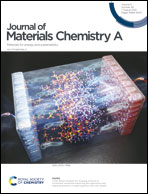Why is the O3 to O1 phase transition hindered in LiNiO2 on full delithiation?†
Abstract
Ni-enriched layered materials are utilized as positive electrode materials of high-energy Li-ion batteries. Because electrode reversibility is gradually lost for stoichiometric LiNiO2 after continuous cycles, Ni ions are partially substituted by other metal ions (Co, Mn, Al etc.). However, the origin of deterioration in stoichiometric LiNiO2 is still not fully understand yet. Moreover, the loss of capacities is observed only in the high voltage region (>4.1 V), which is obviously different from the failure mode observed in other electrode materials. Here, we report for the first time the origin of deterioration, which is revealed by an in situ X-ray diffraction study. For fully charged NiO2, Ni ions migrate from original octahedral sites in NiO2 slabs to face-sharing tetrahedral sites in Li layers, by which the O3 to O1 phase transition is suppresed. Note that Ni migration is a reversible process, and the Ni ions migrate back to the original octahedral sites on discharge. However, after continuous cycles, the reversibility of Ni migration is gradually lost, and Ni ions are partially left at the tetrahedral sites in Li layers. Electrode kinetics are also deteriorated because of the Ni occupation in Li layers, and the accumulation of Ni ions at tetrahedral sites results in the loss of reversible capacities in the high voltage region. This finding opens a new way to design high-capacity Ni-enriched electrode materials, leading to the development of high-energy Li-ion batteries.

- This article is part of the themed collection: Journal of Materials Chemistry A Lunar New Year collection 2022


 Please wait while we load your content...
Please wait while we load your content...